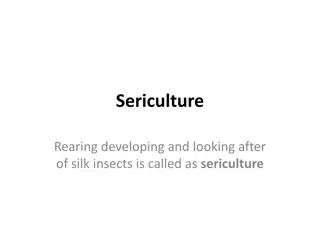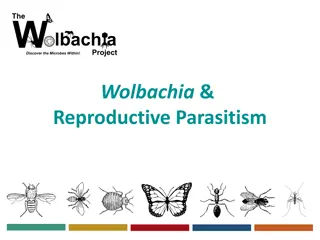Fascinating World of Arthropods: From Insects to Arachnids
Arthropods, the largest and most successful group in the animal kingdom, encompass a wide range of organisms, including insects, arachnids, myriapods, and crustaceans. Insects, with their distinct body regions and exoskeleton, play crucial roles in ecosystems. Arachnids, such as scorpions and spiders, have unique body structures adapted for their habitats. Explore the diversity and characteristics of these fascinating creatures in the world of arthropods.
Download Presentation

Please find below an Image/Link to download the presentation.
The content on the website is provided AS IS for your information and personal use only. It may not be sold, licensed, or shared on other websites without obtaining consent from the author.If you encounter any issues during the download, it is possible that the publisher has removed the file from their server.
You are allowed to download the files provided on this website for personal or commercial use, subject to the condition that they are used lawfully. All files are the property of their respective owners.
The content on the website is provided AS IS for your information and personal use only. It may not be sold, licensed, or shared on other websites without obtaining consent from the author.
E N D
Presentation Transcript
ARTHROPODS ARTHROPODS LUC A MART N
INDEX INDEX Origen Characteristics Insects Arachnis Myriapods Crustaceans Athopods and human beings
ORIGEN Arthropods are the largest and most successful group in the animal kingdom. Comprise a variety of different organisms, from the extinct trilobites, to crabs and lobsters (crustaceans), spiders, horseshoe crabs, scorpions and mites. Centipedes and millipedes and the most diverse, insects (hexapod).
INSECTS The body of all adult insect is divided into three specialized regions: head , thorax and abdomen. The function of each of the regions is diverse body of all adult insect is divided into three specialized regions: head , thorax and abdomen. The function of each of the regions is varied depending on the order of insects . Generally the head has a supply and sensory function , an engine function the thorax and abdomen visceral functions , sometimes mating and sensory functions. Insects have an external skeleton called exoskeleton covered by a protective substance called chitin , it provides protection , support and locomotion, avoiding the loss of internal water , minimizing ultraviolet radiation and serving as a means of communication with the outside .
Depending of the insect order . Generally the head has a supply and sensory function , an engine function the thorax and abdomen visceral functions , sometimes mating and sensory functions. Insects have an external skeleton called exoskeleton covered by a protective substance called chitin , it provides protection , support and locomotion, avoiding the loss of internal water , minimizing ultraviolet radiation and serving as a means of communication with the outside .
ARACHNIS Arachnid, term for animals in the class including the scorpions, spiders, daddy longlegs, mites, and ticks, and certain other eight-legged land invertebrates. Fossils suggest that arachnids were among the first animals to live on land, perhaps in the early Devonian Period, nearly 400 million years ago. About 60,000 species are known, although many, especially mites, remain undiscovered or undescribed. Arachnids are found throughout the world in nearly every habitat, but they reach their greatest size and diversity in warm arid and tropical regions.
The arachnid body is divided into two parts: anterior and posterior. The anterior part, called the cephalothorax, contains sense organs, mouthparts, and limbs in pairs. The first pair of limbs-the chelicerae- may form pincers or poison fangs, and the second pair-the pedipalps- may serve as pincers, feelers, or legs. The other limb pairs, generally four, are used for walking. The posterior part of the body, the abdomen, bears the genital opening and other structures. It is usually equipped with modified gills called book lungs. Most arachnids are solitary except at the time of mating, when a variety of complex behavior patterns may be observed. Females may guard eggs or young, which are often born live.
MYDIAPODS They live under rocks and rotting logs, feeding on the remains of plants, worms, insects and dead animals. Have a head with two antennas, a pair of jaws and an elongated and flattened trunk comprises many segments (10 to 200). Some have a pair of chelicerae poisonous in the first segment. They live under rocks and rotting logs, feeding on the remains of plants, worms, insects and dead animals. Have a head with two antennas, a pair of jaws and an elongated and flattened trunk comprises many segments (10 to 200). Some have a pair of chelicerae poisonous in the first segment.
CRUSTACEANS Most live in the sea, also some can live in fresh water (eg. water fleas, crayfish, etc.) or brackish water. Among the few terrestrial crustaceans are the piglets or sow bugs. They have mandibles, two pairs of antennae and body usually divided into two parts called carapace (shell) and abdomen. In some species the first pair of legs is modified as grasping forceps with food or defend themselves.
ATHOPODS AND HUMAN BEINGS Humans use arthropods for food. We eat lobster, crabs, shrimp. In other countries, grasshoppers, beetle grubs, and (less common) caterpillars are eaten. We compete with insects for food. There are insects which eat crops in the field, and insects which eat stored grain. Insects destroy some of our manufactured goods. Termites turn wood into frass. So, wood buildings are not going to last forever. There are caterpillars which will chew on wool cloth. There are arthropods which will eat book bindings, and old paper. Some arthropods are parasitic on humans -- there are fleas, chiggers, mosquitoes, mites, and lice, that make us itch and scratch.
Exercicies http://concurso.cnice.mec.es/cnice2006/material036/web_publicar/artrop odos.html
Video http://www.teachertube.com/viewVideo.php?video_id=92484
END END























